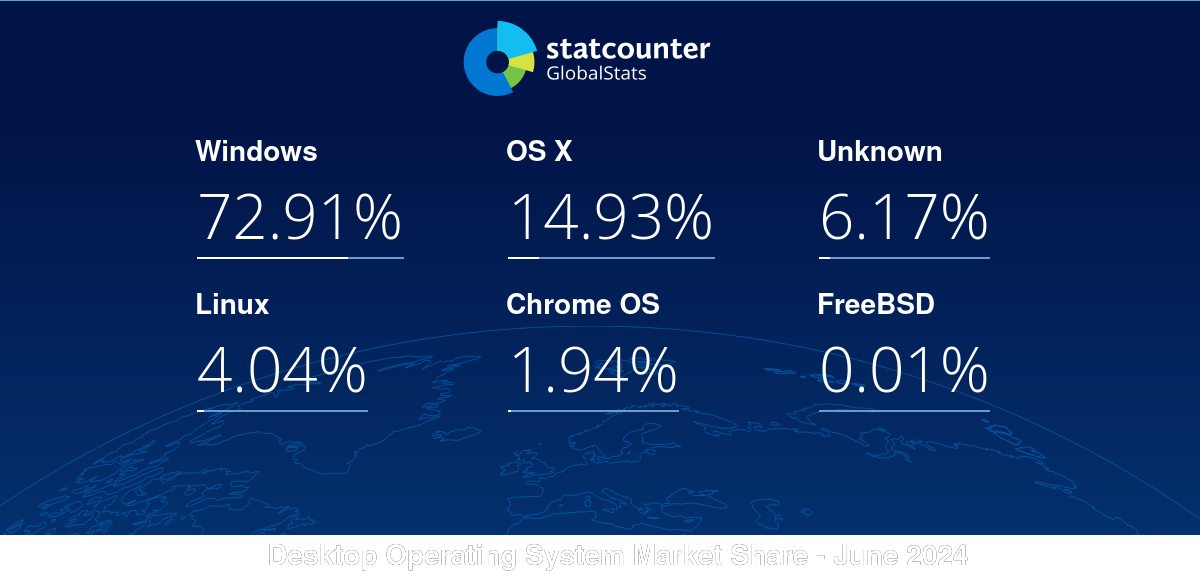It peaked at 4.05% in March. The last 2 months it went just below 4% as the Unknown category increased. For June the reverse happened, so 4.04% seems to be the real current share of Linux on Desktop as desktop clients were read properly/werent spoofed.



Windows 11: Add advertisement to the start menu, add remote Artificial intelligence to your daily live. Require new CPUs and motherboards / hardware, ignoring the market for old computers.
What will they do next?
This is why I expect Linux share to slowly increase until the old computers die and you will not be allowed to choose to boot another operating system besides Windows on your Microsoft-Copilot+ PC that would be your only option.
Windows decline has nothing to do with any of the actual features.
It is declining because fewer people are buying PCs anymore. Every one is using a mobile device or tablet.
This is also the reason they are squeezing windows harder to make up for the down turn.
This is clearly a statistic about PCs, otherwise the share wouldnt be ~73% windows. So the decline of the desktop PC doesnt really matter here
The people who are more likely to retain a PC and not just use a phone, are more likely to be tech literate power users.
This selects against casual windows users, and selects for hardcore Linux users
But we’re talking about proportions of Desktop operating systems. People using the desktop less might decrease (or slow the increase) of total desktop usage; but there would need to be more reason that just that for it to impact Windows disproportionately.
My brother, who want nothing to do with computers if he can, asked me to install Linux on his domestic laptop. It’s not an everyone is doing it yet, but there’s definitely something.
Forcing everyone to stay connected will make pirating it harder, and that will drive many, many people away.
Fair enough, I am looking into buying PC only as a server, but as I am kind of migrant still trying to settle down it will be somewhere in 2025, if not 2026. And right now laptop + phone cover basically all my needs i.e. work, gaming, reading, surfing the web, interacting with the local government. Not to mention that it is much easier to get around with those compared to the headache that is moving PC :)
And from my experience most PC users now are either people who bought it 10+ years ago and they just still have it, or people really invested into AAA gaming. Everyone else has combination of smatphone and tablet/laptop.
Next:
Must always be online
Cost is now $9.99 per month (free with commercial breaks. For now of course.)
Everything is stored online (60GB free, $5.99/month to up it to 199GB, $49/m for 400GB).
The thing is that most Windows users don’t care and will continue to use it. People like you and I know about the benefits of Linux, but sometimes we overestimate how much regular users care about the OS they’re using.
If anything, they’re moving in the opposite direction. Windows Server 2025 is going to support hotpatching, which means that system updates can be applied without needing to reboot. Not sure if the technology will come to consumer Windows though.
How long do you expect legacy hardware to be supported for?
I dunno, longer than 6 years, which is about how long it took for Skylake to go from brand new to not being supported by the new version of Windows?
And I honestly can’t think of a time that’s even happened before when you could get 10 running on 10+ year old processors as long as they were powerful enough. And the difference between a Core 2 Duo and a Skylake i7 is vastly more than between the Skylake i7 and the current generation.
The issue is not that the hardware stops getting support, either… It’s that the hardware is expressly and needlessly being blocked long before it’s no longer useful. My old Skylake is now 9 years old and more than capable of running as a moderate power machine on current workloads, other than being forcibly blocked to encourage me to put it in a landfill so I can continue the consumer march for more stuff to feed the corpos.
It’s wasteful. And for the most part, all that’s needed is for the old drivers to be allowed to function. And to make things like TPM 2 be optional, especially considering I don’t think you’re even required to actually use it for Windows 11, just have it.
Interesting… I didn’t realise Skylake isn’t supported. I agree with your comment. I thought people were talking about much older equipment.
TPM 2 has been around since 2015ish and I wouldn’t be surprised if Windows starts relying on it more heavily. A lot of businesses have already required employees to use computers with TPM 2.0 for a long time, and enterprise use is a big focus for Microsoft.
I have some Sandy Bridge systems here running strong as Linux desktops for light work. You know, these 4-core 3,3GHz processors from - hmm - 2014?